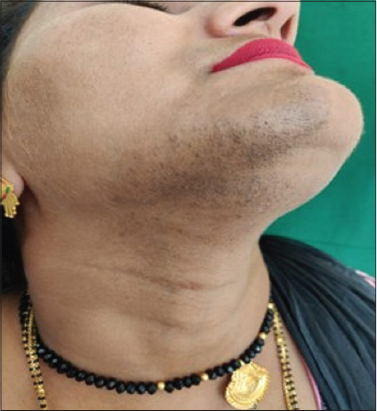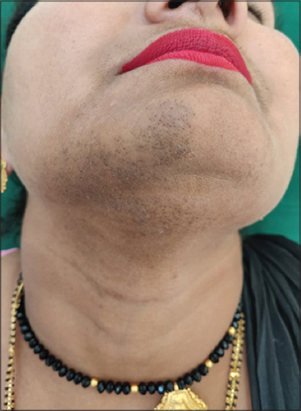Idiopathic unilateral facial hirsutism
Ritu Rani1, Mudita Gupta 2, Reena Kumari Sharma1, Geeta Ram Tegta2
2, Reena Kumari Sharma1, Geeta Ram Tegta2
1Department of dermatology, Civil Hospital Kangra, India, 2Indira Gandhi Medical College, Shimla, India
Corresponding author: Mudita Gupta, MD
How to cite this article: Rani R, Gupta M, Sharma RK, Tegta GR. Idiopathic unilateral facial hirsutism. Our Dermatol Online. 2022;13(2):190-192.
Submission: 01.02.2021; Acceptance: 03.08.2021
DOI: 10.7241/ourd.20222.18
Citation tools:
Our Dermatology Online 2022. No commercial re-use. See rights and permissions. Published by Our Dermatology Online.
ABSTRACT
Hirsutism is the growth of terminal hair in a female in a male-like distribution. Idiopathic hirsutism (IH) is when there is no increase in circulating androgens or ovarian hormones. IH usually involves multiple sites with variable densities. Localized and unilateral dermatomal hirsutism has been rarely described. We report a forty-year-old female with a history of terminal hair growth on the left side of the chin. There was no associated biochemical or ultrasonic evidence of hyperandrogenism suggesting it to be idiopathic.
Key words: Idiopathic Hirsutism; Unilateral; Localized
INTRODUCTION
Hypertrichosis is a term that refers to excessive hair growth on any part of the body or the entire body as compared to individuals of the same age, sex, and race [1]. The term hirsutism is applied to the androgen-induced growth of terminal hair in women and children in a male-like distribution [2]. Polycystic ovary syndrome (PCOS), androgen-secreting tumors, non-classic adrenal hyperplasia (NCAH), or syndromes of severe insulin resistance are the known causes of hirsutism. Idiopathic hirsutism is an unknown cause of terminal hair in an androgenic distribution. Hair growth secondary to any systemic cause such as other normal cutaneous processes shows bilateral symmetry. Terminal facial hair growth in a unilateral distribution is unusual. Herein, we report the case of a forty-year-old female with a history of unilateral facial hirsutism persistent for the last five to six years.
CASE REPORT
A forty-year-old female presented with a history of facial hair growth localized on the left side of the face persistent for the last five to six years. She denied any history of topical application, irritants, any medicine taken in the last three months, trauma, or surgery on the site affected. She had normal menstrual cycles and had no family history of hirsutism. She had three children, with the youngest fourteen years old. On physical examination, she had dense terminal hair growth on the left side of the chin that extended exactly to the midline of the chin without any hair growth on the other side of the chin (Figs. 1 and 2). The skin on both sides of the face was of normal texture and pigmentation. The vellus hair growth in the rest of the face was normal for her age. There was no other evidence of virilism. Routine laboratory investigations (complete hemogram, liver and renal function tests, serum electrolytes, a lipid profile, thyroid function tests, fasting blood sugar) were done and found to be within normal limits. In addition, serum follicular stimulating hormone, luteinizing hormone (and their ratio), serum testosterone levels, serum prolactin, and serum dehydroepiandrosterone and 17-hydroxyprogesterone were also within normal limits. Insulin resistance was calculated with the homeostasis model assessment of insulin resistance (HOMA-IR) and was found to be normal. Ultrasound for the pelvic organs and adrenals was normal. The patient was hence diagnosed to have idiopathic hirsutism in a unilateral distribution.
 |
Figure 1: Terminal hair on the chin, mandible, and neck on the right side. |
 |
Figure 2: Sharp demarcation of terminal hair growth on the midline. |
DISCUSSION
Terminal hair growth is associated with androgenetic hormonal influences, both internal and external to the follicle, external stimuli, and congenital anomalies [3]. Idiopathic hirsutism (IH) is also known as simple or peripheral hirsutism. IH is the diagnostic label given to those hirsute females in whom no overt underlying endocrine disorder (ovarian function and circulating androgens) could be detected [2]. Less than 20% of females with hirsutism are diagnosed as idiopathic [4]. A history of regular menstrual cycles does not rule out ovulatory dysfunction and polycystic ovarian syndrome. The primary pathology in IH is unknown but, as the name suggests, the alteration is somewhere in the periphery or in the target area. There may be an increase in skin 5-alpha-reductase levels. The level of DHT may be normal despite an increase in 5-alpha-reductase activity due to its quick metabolism in the skin, hence leading to local action only. Treatment with 5-alpha-reductase inhibitors is helpful while reducing androgen secretion with the help of oral contraceptive pills (OCPs) is of limited value in IH. Other proposed pathogenetic mechanisms of IH are androgen receptor gene polymorphism and increased sensitivity of hair follicles to androgens. Various growth factors, for instance, transforming growth factor-b and epidermal growth factor, and cytokines have been observed to affect hair growth [5]. It has been suggested that these factors operate by increasing the synthesis of stromelysin, a matrix metalloproteinase that acts on the dermal papilla to accelerate growth.
A dermatomal pattern of hair growth is unusual, as seen in our case. No congenital abnormality or history of external stimuli to the area were noted. She may have had relative hyperresponsiveness to circulating androgens on the terminal hairside or hyporesponsiveness on the vellus hairside.
Ellis reported a female with unilateral hirsutism involving the entire right side of the body and associated with polydactyly, premature fusion of the epiphyses of the right leg, and myasthenia gravis [6]. Androgen metabolic activity in the skin on both sides in this case was in the low normal range, while plasma testosterone values were in the normal female range. In 1886, Humphry reported a twelve-year-old girl with unilateral facial hirsutism associated with ipsilateral gingival hyperplasia [7].
Local determinants of hair growth play an important role in IH. In our case, the response to the same systemic hormonal stimuli to the individual follicles on one side of the face was different than on the other side.
Consent
The examination of the patient was conducted according to the principles of the Declaration of Helsinki.
The authors certify that they have obtained all appropriate patient consent forms, in which the patients gave their consent for images and other clinical information to be included in the journal. The patients understand that their names and initials will not be published and due effort will be made to conceal their identity, but that anonymity cannot be guaranteed.
REFERENCES
1. Maheshwari A, Dhaked DR, Meena RS. Localized hypertrichosis at unusual sites. Indian J Paediatr Dermatol. 2017;18:346-8.
2. Messenger AG, Sinclair R D, Berker David. Acquired disorders of hair. In:Griffiths C, Barker J, Bleiker T, Chalmers R, Creamer D eds. Rook’s Textbook of dermatology, 9th ed. Wiley- Blackwell publishing 2016 p 89.61-4.
3. Grymowicz M, Rudnicka E, Podfigurna A, Napierala P, Smolarcyzk R, Smolarcyzk K, et al. Hormonal effects on hair follicles. Int J Mol Sci. 2020;21:5342.
4. Sachdeva S. Hirsutism:Evaluation and treatment. Indian J Dermatol. 2010;55:3-7.
5. Hohl A, Ronsoni MF, Oliveira Md. Hirsutism:Diagnosis and treatment. Arq Bras Endocrinol Metabol. 2014;58:97-107.
6. Ellis JP. Unilateral hirsutism, epithelial naevus, polydactyly, premature fusion of epiphyses of right leg, and myasthenia gravis. Br J Dermatol. 1971;84:385-6.
7. Humphry GM. Unilateral hypertrophy of the gums associated with other abnormalities, chiefly hypertrophic and unilateral. Ann Surg. 1886;3:1-8.
Notes
Source of Support: Nil,
Conflict of Interest: None declared.
Request permissions
If you wish to reuse any or all of this article please use the e-mail (brzezoo77@yahoo.com) to contact with publisher.
| Related Articles | Search Authors in |
|
|



Comments are closed.